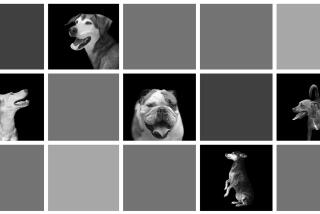The Siren’s Call: Man’s worship of — and cruelty to — dogs
- Share via
Dogs rule. The writers of ABC’s “Lost” know that. In the series finale, they gave viewers an unforgettable, tear-jerker scene: Vincent the lab stays at the side of the dying Jack. Jack’s not alone. When he breathes his last, viewers knew that Vincent would be there.
Dogs symbolize many things, not always positive — more on that later — but the meaning most often associated with them, whether on “Lost” or this publishing season, is loyalty … loyalty of epic, almost mythic, dimensions.
It’s a quality coming from dogs’ earliest relationships with humans: They guarded our ancestors as they dozed by campfires and were given food, affection and company in return. A relationship based on mutual benefits. A relationship that can be misused.
Dogfighters, for instance, add fear, pain and hunger to the equation so that these pack animals turn into solitary fighters. Dogfighting, Jim Gorant tells us in “The Lost Dogs: Michael Vick’s Dogs and Their Tale of Rescue and Redemption” (Gotham: 290 pp., $26), can be a small-time operation — two owners, say, having their dogs face off in an alley somewhere — or an activity on the scale of NFL superstar Vick’s enterprise.
In “The Lost Dogs” Gorant describes what went on at Bad Newz Kennels, Vick’s pitbull-fighting operation in Virginia, and how it was busted by local and federal authorities in the middle of 2007. Even though we know what has happened — Vick pled guilty, spent time in prison (he’s back on the field with the Philadelphia Eagles), many of the pit bulls were rehabilitated — “The Lost Dogs” still has the quality of a page-turner as it chronicles the entire story, in all its upsetting detail, of the dogs’ rescue and re-entry into the world.
Not all the readers of Sports Illustrated, where Gorant is a senior editor, thought his cover story on Vick’s dogs was such a page turner. The magazine was flooded with complaints that, Gorant says, boiled down to this sentiment: What did this article have to do with sports? These are dogs — why should we care?
Why?
“[A]s man rose in the world,” Gorant explains, “dogs came with us, perhaps even aiding the advance. They continued to guard us and help with hunting, but they did more. They marched with armies into war, they worked by our side…. From the start it was a compact: You do this for us and we’ll do that for you.”
It might sound like hyperbole, but many scientists and science writers share this view. Jeffrey Moussaieff Masson, in “The Dog Who Couldn’t Stop Loving: How Dogs Have Captured Our Hearts for Thousands of Years” (Harper: 250 pp., $25.99), even writes about there being a mutual evolutionary effect in the human-dog relationship. We might marvel at how canis lupus (wolf) evolved into canis lupus familiaris (dog), but what did humans get out this long process of dog domestication? (Scientists say this domestication took place anywhere from 15,000 years to 150,000 years ago.)
“What does it mean,” Masson asks, “to say ‘dogs make us human’?”
Though Masson says research and archeology are scant in answering that question, he delves into many issues — why dogs bite, neoteny (which refers to the puppylike behavior dogs keep into adulthood), the qualities of friendliness, affection and playfulness they share with us, their abilities to smile and apologize. He sums up veterinarian David Paxton’s theory about the human sense of smell: The bond between humans and dogs “allowed humans to dispense with smell … and develop language instead.” And canine patience and loyalty just might have rubbed off on early humans just as, in the world of psychology, a patient “might transfer feelings onto his therapist.”
Masson’s narrative is helped along by interspersing the science with anecdotes about the dog he and his family love, an 80-pound golden lab named Benjy. Masson is in awe of the gentleness of this pooch, who failed as a trained guide dog because, Masson said, Benjy was “made for loving.”
Masson is so exuberant that you forget all those other images of dogs. Darker ones. Think of Robert Johnson singing about hellhounds on his trail or of the phrases “dogs of war” and “dog eat dog.” What are those all about? And who can forget that beast that menaced the Baskerville family in Conan Doyle’s tale?
Older still, Greeks feared Cerberus, a terrifying three-headed canine guarding the gates of Hell in ancient myth. Cerberus’ drool, Philip Matyszak tells us in his “The Greek and Roman Myths: A Guide to the Classical Stories” (Thames & Hudson: 224 pp., $24.95), was so lethal that drops of it fell and turned into poisonous flowers.
Such cultural references remind us of the fierce side of dogs — as do the headlines. It is big news any time a pit bull attack occurs, and even though the pit bull embodies savageness for many people today, Gorant points out that in the past many other dogs have held this infamous position, including bloodhounds, German shepherds and Doberman pinschers.
As for pit bulls?
“In the mid-1970s,” Gorant writes, “enterprising reporters began writing about the underground world of dogfighting, in hope of exposing and ending the practice.… This had the effect of promoting pit bulls as next in the line of tough-guy dogs.”
Masson’s book brims with an exuberance that is infectious, while Gorant is far more restrained, bringing a steady, objective hand to a story that would have been easy to sensationalize.
It would be very easy, for instance, to paint Vick in the most villainous terms —something Gorant really doesn’t do — in comparing the suffering of the dogs (the breeding apparatus where the female is strapped, for instance, is here called a “rape stand”) to the financial gain Vick clearly didn’t need. Dogfighting wagers, Gorant says, can amount to $20,000 or $30,000 and “sometimes shoot even higher than that, into the hundreds of thousands.” Breeding is even more profitable, but wouldn’t these numbers mean little to a man who received a 10-year contract with the Atlanta Falcons for $130 million? And yet, Gorant tries to understand the motivation from Vick’s point of view.
“The metaphorical leap that seduces so many into the world of dogfighting was a short one for guys like Vick [and his associates]. They saw themselves in the dogs. In the exterior toughness and bravado, to a degree, but even more in the animals’ willingness to take on any challenge, to endure pain and injury, to never give up despite long odds … perfect symbols of their own triumph.”
If Gorant is right, then one can only wonder: How does this noble image of those wonderful, complicated creatures lead to such hideous treatment?
Owchar is deputy book editor. The Siren’s Call appears monthly at http://161.35.110.226/books.
More to Read
The biggest entertainment stories
Get our big stories about Hollywood, film, television, music, arts, culture and more right in your inbox as soon as they publish.
You may occasionally receive promotional content from the Los Angeles Times.










